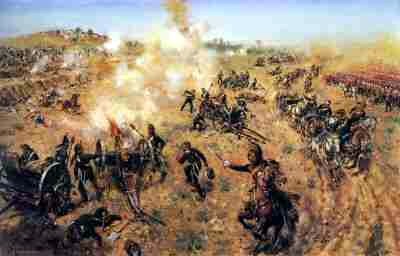The Battle of Hyderabad
The Battle of Hyderabad
At the end of the first Afghan War the Chieftains of Sind in North-west India united in an attempt to drive the British from the area.
General Sir Charles Napier the Military Commander of the Province decided that the minor skirmishes had reached an unacceptable level, and assembled a small mobile force to deal with the situation. By mid March 1843 only one leader remained, Shere Mohamed “The Lion”. Napier’s force was encamped in the walled city of Hyderabad from where an ultimatum was issued to Shere Mohamed calling for his surrender or Napier would attack.
On 22nd March after an exhausting march a Brigade including 1st Troop Bombay Horse Artillery commanded by Captain Leslie arrived at Hyderabad.
These reinforcements brought Napier’s force up to 5000 men. On the 24th March General Napier committed his force to battle just outside the walled city, they faced a combined force of 40,000.
The battle began at nine o’clock with Leslie’s Troop moving diagonally across the battlefield in front of the infantry, halting, firing and re-mounting until they reached a position where they could engage the entire left flank of the enemy. It was during the stage of fire and movement that Lt Smith was killed as he went forward to recce a gun position close to the enemy. He was the Troop’s only fatal casualty of the battle. The sustained fire weakened the enemy and allowed the cavalry on the right flank to charge them, simultaneously the infantry led by Her Majesty's 22nd Regiment (The Cheshire Regiment) made a frontal attack on the enemy position. The cavalry moved around to the right flank to cut of their retreat. Leslie’s Troop, their artillery duties done, crossed the river under heavy enemy fire and charged with the cavalry.
After the battle Leslie noted that ‘we descended down a steep bank and one of my trumpeters had gone ahead up the far bank and seized a banner amidst a hail of bullets. Waving the banner he shouted “this way to honour, this way” and led the Troop in support of the infantry’. The battle of Hyderabad marked the end of the Sind campaign although Shere Mohamed escaped.
General Napier later wrote that ‘the battle was decided by the Troop of Horse Artillery and Her Majesty’s Cheshire Regiment’. On the 11th April 1843 the Governor General of India directed that ‘after the merits of the Troop during it’s service in Afghanistan and India, for the many long marches that it had completed, especially the one to join Napier’s force at Hyderabad, it should hereafter be denominated the 1st or Leslie’s Troop of Horse Artillery and shall in additions the appointments of Hyderabad and Afghanistan bear the Eagle.
The Eagle was awarded as a sign of valour and not for any specific deed, but to recognise the contribution the Troop had made to the Afghan and Sind Campaigns.
